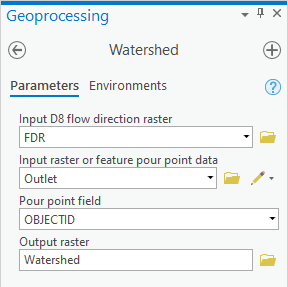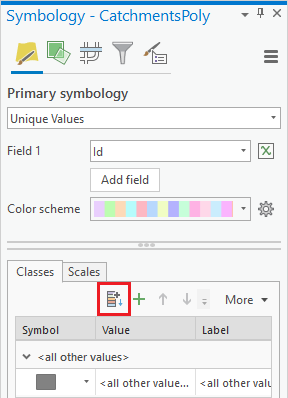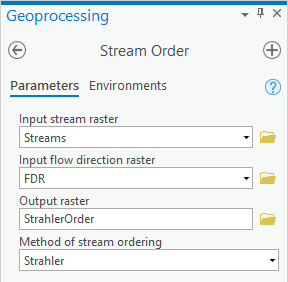...
- At the bottom of the Create Features pane, click the Geoprocessing tab.
- At the top of the Geoprocessing pane, click the Back button.
- In the search box, type "watershed".
- Click the Watershed (Spatial Analyst Tools) tool.
- For ‘Input D8 flow direction raster’, select the FDR raster.
- For ‘Input raster or feature pour point data’ select the Outlet layer.
- For ‘Output raster’, rename the raster from “Watersh_FDR1” to “Watershed”.
- Ensure your Geoprocessing pane appears as shown below and clickRun.
- In the Contents pane, right-click the Watershed layer and select Zoom To Layer.
You can toggle the Subbasin_StatePlane layer on and off. Notice that the watershed boundary you have created is very close, but does not exactly match the boundaries of the subbasin you were originally provided from NHDPlus.
- In the Contents pane, turn off all layers beneath the Watershed layer, so that only the cells within the newly defined subbasin are visible.
...
- Return to the Geoprocessing pane.
- At the top left of the Geoprocessing pane, click the Back button.
- In the search box, type "raster to polygon".
- Click the Raster to Polygon tool.
- For ‘Input raster’, select the Catchments layer CatchmentsRaster layer.
- For ‘Output polyline features’, rename “RatsterT_Catchme1” to “CatchmentPolyCatchmentsPoly”.
- Uncheck Simplify polylinespolygons.
- Ensure your Geoprocessing pane appears as shown below and click Run.
- Symbolize the CatchmentPoly layer using unique values with ID as the value field.
Make sure to click the Add all values button. - In the Contents pane, collapse the CatchmentPoly symbology.
Now you will also convert the raster StreamLinks into a polyline feature class. While you could use the Raster to Polyline tool, you will instead use a tool in the Hydrology toolset, designed specifically for converting raster stream links into polyline features. The difference between the two methods is illustrated below.
- Return to the Geoprocessing pane.
- At the top left of the Geoprocessing pane, click the Back button.
- In the search box, type "stream".
- Click the Stream to Feature tool.
- For ‘Input stream raster’, select the StreamLinks layer raster.
- For ‘Input flow direction raster’, select the FDR layer raster.
- For ‘Output polyline features’, rename the feature class from “StreamT_StreamL1” to “DrainageLines”.
- Uncheck Simplify polylines.
- Ensure your Geoprocessing pane appears as shown below and click Run.
Calculating Strahler stream order
...
- At the top left of the Geoprocessing pane, click the Back button.
- In the search box, type "stream".
- Click the Stream Order tool.
- For ‘Input stream raster’, select the Streams layer raster.
- For ‘Input flow direction raster’, select the FDR layer raster.
- For ‘Output raster’, rename the raster from “StreamO_Stre1” to “StrahlerOrder”.
- Ensure your Geoprocessing pane appears as shown below and click Run.
- In the Contents pane, turn off all layers except for the new StrahlerOrder layer, so that its symbology is more apparent.
...














